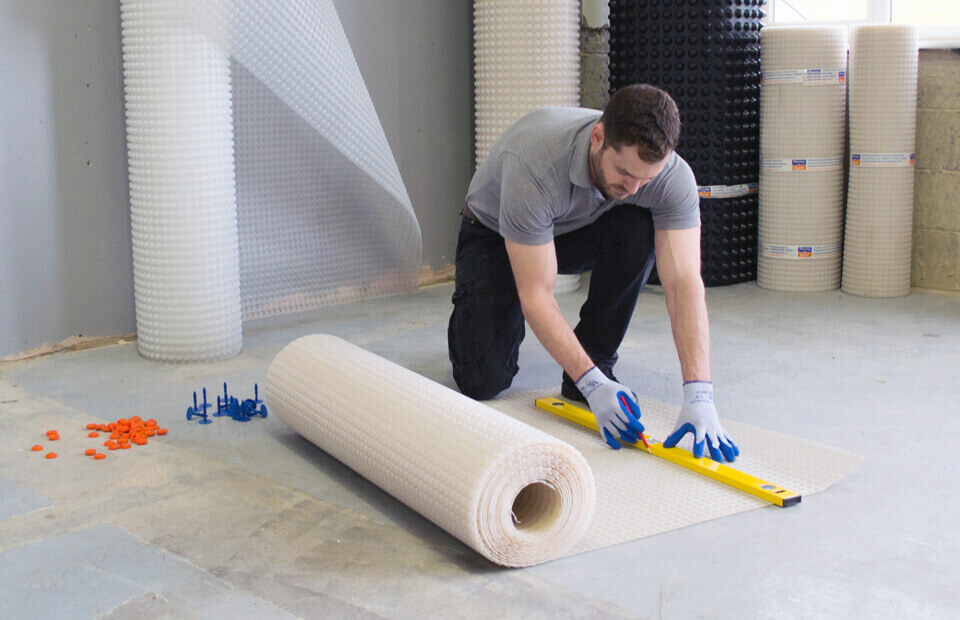If you’ve spotted signs of damp in your home—peeling paint, musty smells, black mould patches—you’re probably wondering what it’ll cost to sort it out. The truth is, damp proofing costs can vary a lot depending on how serious the issue is and what type of treatment your home needs.
In this guide, we’ll break down typical prices for everything from a basic damp course to full basement waterproofing, so you know what to expect before picking up the phone for quotes.
Quick Answer: How much does damp proofing cost in the UK?
Damp proofing in the UK typically costs between £400 and £6,000, depending on the severity and size of the area treated. A basic damp proof course (DPC) starts from £500, while chemical injection DPCs average £70–£120 per metre. Basement treatments and older homes may cost more due to extra materials and labour. Always check if plastering and finishes are included in the quote.
What Is Damp Proofing and Why Does It Matter?
Damp proofing is a way of stopping moisture from getting into your walls or floors. It protects your home from things like rising damp, leaking walls, and excess condensation—all of which can lead to mould, rotting timber, and damaged plaster if left untreated.
There are different types of damp proofing, depending on the problem:
- Rising damp comes up from the ground through brickwork
- Penetrating damp gets in from outside due to leaks or cracks
- Condensation builds up inside, often in bathrooms or cold rooms
Getting damp fixed early is important. It can save you money in the long run by avoiding costly repairs like replacing plaster, skirting boards, or even floor joists. According to the Energy Saving Trust, rising damp often occurs when a damp-proof course fails or isn’t installed—treating it early helps protect your home and keeps it compliant with modern building regulations.
In most cases, a damp assessment is the first step. Some companies offer this for free, while others charge around £100–£250, especially if a detailed report is needed for mortgage or insurance purposes.
Average Damp Proofing Costs in the UK
So, how much will it set you back? In 2025, typical damp proofing costs range from £400 to over £6,000, depending on the area and method used. According to Checkatrade, full-house treatments average around £5,000, while localised fixes may cost much less. Small jobs like treating one wall might be on the lower end. But if you need full-house treatment or basement tanking, expect to pay more.
Here’s a general idea:
- Small repair (1 wall) – from £400–£800
- Mid-size job (2–3 rooms) – £1,000–£2,500
- Whole house – £2,500–£6,000+
Some companies quote by square metre. On average, expect to pay £70–£120 per m², depending on the method used and how much prep is needed.
Keep in mind, these prices usually don’t include re-plastering or painting afterward—so budget extra if you want your walls finished neatly.
How Much Does a Damp Proof Course (DPC) Cost?
A damp proof course, or DPC, is a barrier designed to stop rising damp from soaking up through your walls. Most modern homes already have one built in, but older properties may have failed systems—or none at all.
Average Cost of a DPC in the UK
If you need a new DPC installed, prices typically start from £500 and can go up to £3,000 or more, depending on the size of your property and the method used.
Here’s what to expect:
- 1–2 rooms: £500–£1,200
- Mid-terrace or semi-detached home: £1,500–£2,500
- Detached or larger property: £2,500–£4,000
What’s Included?
Most DPC installations include:
- Damp injection treatment (chemical solution)
- Drilling into affected brickwork
- Replastering (sometimes an added charge)
- Optional membrane or barrier layer depending on wall type
Note: If your property is older or built with lime mortar, you may need specialist DPC work—this can push the cost up due to extra labour and materials.
Injection Damp Proofing Cost Breakdown
Injection damp proofing is one of the most common ways to treat rising damp. It involves drilling holes into your walls and injecting a water-repellent chemical to create a barrier that stops moisture from rising.
How Much Does Injection DPC Cost?
On average, injection damp proofing costs between £70 and £120 per metre of wall treated. For a full room, you might pay £500–£1,000, depending on the wall length, height, and how much prep work is needed.
Here’s a rough breakdown:
- Small wall section: from £200
- Full ground floor of a terraced house: £1,000–£2,000
- Larger detached house: £2,000–£4,000+
Chemical DPC vs Other Methods
Injection is usually cheaper than full membrane systems or tanking, but it may not be suitable if your home has severe penetrating damp or major structural issues.
Some homeowners try DIY kits (around £60–£150), but mistakes in drilling depth or spacing can lead to repeat problems—so it’s often best left to professionals.
Heads up: Replastering after injection adds to the cost, so always ask if that’s included in your quote.
Damp Proofing Costs by Area: Walls, Basements, and More
Not all damp problems happen in the same place, and the location of the damp can make a big difference to the overall cost. Here’s what to expect depending on where the issue is.
External Walls
Damp in outside walls is usually caused by water getting in through cracks, damaged render, or missing mortar. Fixing it may involve a mix of injection DPC, sealing the wall, or applying breathable render.
- Average cost: £1,000–£3,500
- Includes: damp treatment, render repairs, possibly scaffolding
Tip: The higher the wall, the more it costs—access can be tricky and may require extra labour or equipment.
Cellars and Basements
Basement damp is a different beast. It’s not just about stopping damp from rising—it’s about keeping water out entirely. This usually means installing a waterproof tanking membrane, drainage channels, and possibly a sump pump.
- Average cost: £2,000–£10,000+
- Tanking alone may cost £60–£100 per m²
- More complex systems (like cavity drain membranes with pumps) push the cost higher
Good to know: Basement damp proofing is the most expensive type, but it adds long-term value and makes the space usable for storage, living, or utility purposes.
Damp Proofing Costs by Area: Walls, Basements, and More
Not all damp problems happen in the same place, and the location of the damp can make a big difference to the overall cost. Here’s what to expect depending on where the issue is.
External Walls
Damp in outside walls is usually caused by water getting in through cracks, damaged render, or missing mortar. Fixing it may involve a mix of injection DPC, sealing the wall, or applying breathable render.
- Average cost: £1,000–£3,500
- Includes: damp treatment, render repairs, possibly scaffolding
Tip: The higher the wall, the more it costs—access can be tricky and may require extra labour or equipment.
Cellars and Basements
Basement damp is a different beast. It’s not just about stopping damp from rising—it’s about keeping water out entirely. This usually means installing a waterproof tanking membrane, drainage channels, and possibly a sump pump.
- Average cost: £2,000–£10,000+
- Tanking alone may cost £60–£100 per m²
- More complex systems (like cavity drain membranes with pumps) push the cost higher
Good to know: Basement damp proofing is the most expensive type, but it adds long-term value and makes the space usable for storage, living, or utility purposes.
What Affects the Cost of Damp Proofing?
Damp proofing quotes can vary a lot, and that’s because several factors influence the final price. Knowing what affects cost can help you budget more accurately—and avoid surprises.
1. Size of the Treated Area
The bigger the space, the more materials and labour you’ll need. Treating one wall is far cheaper than damp proofing an entire ground floor.
2. Type of Damp
Rising damp is usually treated with injection, while penetrating damp might need external work. Condensation, on the other hand, could just need better ventilation—which costs far less.
3. Property Age and Build Type
Older homes with solid brick or stone walls often need breathable materials and more care, which increases labour and material costs.
4. Access
Difficult-to-reach areas (like behind stairs or under floors) may take longer and cost more to work on—especially if furniture or flooring needs to be removed.
5. Plastering and Finishes
Some quotes include re-plastering; others don’t. A full skim coat or new plasterboard can add £300–£800+, depending on room size.
6. DIY vs Professional
DIY kits are cheaper upfront but easy to get wrong. Hiring a certified damp specialist may cost more initially, but they’ll often include warranties and detailed reports—especially useful if you’re selling or renovating.
Final Thoughts: Is Damp Proofing Worth the Cost?
Damp proofing might not be the most exciting job on your to-do list, but it’s one of the most important if you want to protect your home. Left untreated, damp can lead to mould, timber rot, ruined walls, and even health issues—making things far more expensive in the long run.
So, is it worth it?
Yes—especially if:
- You plan to sell or rent out your home
- The damp is spreading or affecting more than one room
- You’ve already spent money redecorating, only for the stains to return
When to Get Help
If you’re unsure what type of damp you’re dealing with, start with a professional damp assessment. Some companies offer this for free; others may charge £100–£250 for a full report. It’s worth it to get a clear plan of action and an accurate quote.
Quick Recap:
- Small jobs start from £400, full home treatments can reach £6,000+
- DPC injections range from £70–£120 per metre
- Basements and old homes often cost more
- Always ask if plastering is included in your quote
Tackling damp early saves money, protects your structure, and makes your home feel fresher and healthier.

